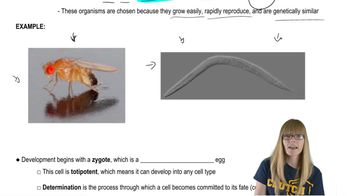Table of contents
- 1. Introduction to Genetics51m
- 2. Mendel's Laws of Inheritance3h 37m
- 3. Extensions to Mendelian Inheritance2h 41m
- 4. Genetic Mapping and Linkage2h 28m
- 5. Genetics of Bacteria and Viruses1h 21m
- 6. Chromosomal Variation1h 48m
- 7. DNA and Chromosome Structure56m
- 8. DNA Replication1h 10m
- 9. Mitosis and Meiosis1h 34m
- 10. Transcription1h 0m
- 11. Translation58m
- 12. Gene Regulation in Prokaryotes1h 19m
- 13. Gene Regulation in Eukaryotes44m
- 14. Genetic Control of Development44m
- 15. Genomes and Genomics1h 50m
- 16. Transposable Elements47m
- 17. Mutation, Repair, and Recombination1h 6m
- 18. Molecular Genetic Tools19m
- 19. Cancer Genetics29m
- 20. Quantitative Genetics1h 26m
- 21. Population Genetics50m
- 22. Evolutionary Genetics29m
17. Mutation, Repair, and Recombination
Types of Mutations
Problem 22b
Textbook Question
Many human genes are known to have homologs in the mouse genome. One approach to investigating human hereditary disease is to produce mutations of the mouse homologs of human genes by methods that can precisely target specific nucleotides for mutation. Numerous studies of mutations of the mouse homologs of human genes have yielded valuable information about how gene mutations influence the human disease process. In general terms, describe how and why creating mutations of the mouse homologs can give information about human hereditary disease processes.
 Verified step by step guidance
Verified step by step guidance1
Identify the concept of homologous genes: Homologous genes are genes in different species that evolved from a common ancestral gene. They often retain similar functions across species.
Understand the significance of mouse models: Mice are often used in genetic research because they share a high degree of genetic, biological, and behavioral similarity with humans, making them excellent models for studying human diseases.
Explain the process of creating mutations: Scientists can use techniques like CRISPR-Cas9 to introduce specific mutations into the mouse genome, targeting homologous genes that are similar to human genes associated with diseases.
Discuss the analysis of phenotypic effects: By observing the effects of these mutations in mice, researchers can infer the potential impact of similar mutations in humans, providing insights into disease mechanisms and potential treatments.
Highlight the benefits of this approach: Studying mouse homologs allows researchers to conduct experiments that would be unethical or impractical in humans, thus advancing our understanding of genetic diseases and informing the development of therapeutic strategies.
 Verified video answer for a similar problem:
Verified video answer for a similar problem:This video solution was recommended by our tutors as helpful for the problem above
Video duration:
1mPlay a video:
Was this helpful?
Key Concepts
Here are the essential concepts you must grasp in order to answer the question correctly.
Homologous Genes
Homologous genes are genes in different species that share a common ancestry and often retain similar functions. In the context of genetics, mouse genes that are homologous to human genes can provide insights into gene function and disease mechanisms. By studying these homologs, researchers can infer how mutations in human genes may lead to hereditary diseases.
Recommended video:
Guided course

Mapping Genes
Gene Targeting Techniques
Gene targeting techniques, such as CRISPR-Cas9, allow scientists to make precise alterations to specific nucleotides in a gene. This precision enables the creation of mutations in mouse homologs of human genes, which can mimic human genetic disorders. By observing the effects of these mutations in mice, researchers can better understand the biological processes underlying human diseases.
Recommended video:
Guided course

Mapping Genes
Model Organisms in Genetics
Model organisms, like mice, are extensively used in genetic research due to their genetic, biological, and behavioral similarities to humans. They serve as a practical platform for studying the effects of genetic mutations in a controlled environment. Insights gained from these studies can help elucidate the pathways and mechanisms involved in human hereditary diseases, facilitating the development of potential therapies.
Recommended video:
Guided course

Genetics of Development






